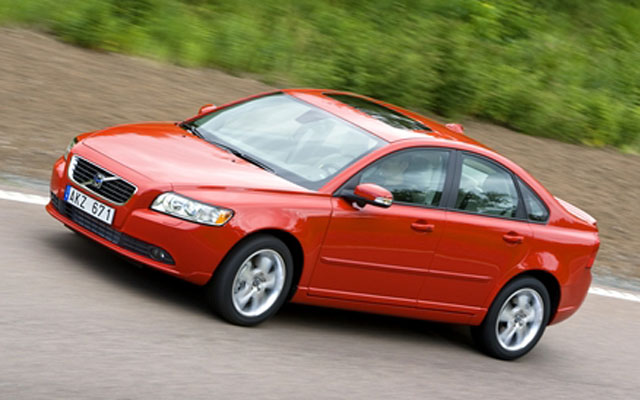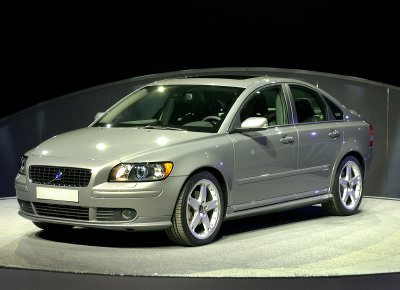Volvo S40
DRIVING DOWN THE ROAD
WITH CAREY RUSS
Volvo, a style leader? Not long ago, that would have been the theme for a Swedish comedy routine. Volvos looked like the boxes they came in. And the only thing less likely than a stylish Volvo would have been a sporty Volvo.
Sure, Volvo has been making turbocharged models since the early 1980s, but Volvo turbos never had much of a following outside a relatively small group of enthusiasts. While those old boxes could be made to go fast enough to embarrass better-known German cars, the work to do so was the province of private parties, at least until Volvo went racing with a factory-backed effort in the British Touring Car Championship in the early 1990s. The initial weapon of choice was a modified 850 wagon, an any laughter was soon quelled when it not only won races, but the championship as well.
When Volvo introduced its first smaller, less-expensive sedan, the S40, in Europe in 1995, that became the basis for Volvo racing efforts. And success continued. The 1995 S40 was notable for other reasons, too - it was one of the first Volvos in recent times to become less boxy. It made its way to the U.S. in 1997.
Meanwhile, Volvo was further developing its own styling language. The first fruit of this was its top-of-the-line S80, which was a design revelation when it was revealed in mid-1998. As then-head designer Peter Horbury put it at the time,
The S80 was followed by the smaller, but similarly-styled S60 sedan and V70 wagon, and Volvo developed a new model nomenclature to go with the new style. Even first digit for sedan, odd for wagon. The S40, and its V40 wagon companion, soldiered on. But with newer models from both German and Japanese competitors in the past few years, they aged rapidly. What to do?
What else but a new generation of S40 sedan, with a companion V50 wagon? The second-generation S40 sedan and V50 wagon are the sportiest of the current Volvo lineup, with the exception of the S60 and V70 ``R'' models, and give Volvo a solid presence in the premium sport-compact segment.
The biggest difference between the S40 and V50 is, of course, that the V50 is a wagon and the S40 is a sedan. Each body style has its advantages and disadvantages - the wagon has a larger carrying capacity and is more versatile, but the sedan weighs 150 lbs less, for better acceleration and handling. It's a question of sport versus utility. Both come with the same power choices - 2.4-liter, 168-horsepower naturally-aspirated or 2.5-liter, 218-hp turbocharged and intercooled inline five-cylinder engines, and turbo versions of both are available with Volvo's all-wheel drive system. The V50 T5 AWD I drove a few months back had the optional five-speed automatic transmission, while the S40 T5 AWD sitting in the driveway at the moment has the standard six-speed manual. The difference between the two transmission choices is the difference between ``sporty'' and ``sports,'' with the manual showcasing the sports-car aspects of the smallest Volvo's personality. In any trim, wagon or sedan, manual or automatic, the new baby Volvo combines the sportiest interpretation of Volvo's current styling with the best performance in the regular Volvo lineup.
APPEARANCE: The broad-shouldered Volvo sedan style that debuted on the elegantly-proportioned S80 was made sleeker with the coupe-like S60, and now has a playful and youthful sport-compact look in the form of the S40. That is only fitting as the S40 is the Volvo designed for younger and more sport-oriented drivers. The S40 is nearly as tall as the mid-sized S60, and has a similarly-long, nearly-fastback roofline, but its shorter wheelbase and length give it chunkier proportions that are playfully muscular. The British might call it ``cheeky,'' as in bold and perhaps offensive to the established order. That's too bad for the established order, but good for Volvo.COMFORT: Except for the obvious differences in layout from its sedan body style, with a separate trunk, the S40 shares the V50's interior styling and appointment. This includes the Scandinavian Modern free-standing brushed-aluminum center stack that looks to be sourced from a high-end audio manufacturer. Not only is it unique, elegant, and very trick-looking, it's highly functional, with self-explanatory controls for the audio and climate-control systems. And it allows extra storage space in  the cabin. It sets the tone for the S40's interior, and helps place the S40 at the upper end of the sport-compact class. The front seats, while different from those in larger Volvos, are just as comfortable. The driver's is power-adjustable, while the passenger's is manual. Upholstery is a grippy cloth. The rear seat is larger than in many competitors, and a 60/40 split with flip-and-fold cushions allows a flat load floor. The trunk is large in capacity, if a bit small in opening size - a common characteristic of small, or even medium-sized sedans. A bicycle can fit through the opening and inside with both wheels removed, but would be easier to get into the V50 wagon. Still, the S40 offers great interior style and design, benchmark comfort, and good versatility.
the cabin. It sets the tone for the S40's interior, and helps place the S40 at the upper end of the sport-compact class. The front seats, while different from those in larger Volvos, are just as comfortable. The driver's is power-adjustable, while the passenger's is manual. Upholstery is a grippy cloth. The rear seat is larger than in many competitors, and a 60/40 split with flip-and-fold cushions allows a flat load floor. The trunk is large in capacity, if a bit small in opening size - a common characteristic of small, or even medium-sized sedans. A bicycle can fit through the opening and inside with both wheels removed, but would be easier to get into the V50 wagon. Still, the S40 offers great interior style and design, benchmark comfort, and good versatility.
 the cabin. It sets the tone for the S40's interior, and helps place the S40 at the upper end of the sport-compact class. The front seats, while different from those in larger Volvos, are just as comfortable. The driver's is power-adjustable, while the passenger's is manual. Upholstery is a grippy cloth. The rear seat is larger than in many competitors, and a 60/40 split with flip-and-fold cushions allows a flat load floor. The trunk is large in capacity, if a bit small in opening size - a common characteristic of small, or even medium-sized sedans. A bicycle can fit through the opening and inside with both wheels removed, but would be easier to get into the V50 wagon. Still, the S40 offers great interior style and design, benchmark comfort, and good versatility.
the cabin. It sets the tone for the S40's interior, and helps place the S40 at the upper end of the sport-compact class. The front seats, while different from those in larger Volvos, are just as comfortable. The driver's is power-adjustable, while the passenger's is manual. Upholstery is a grippy cloth. The rear seat is larger than in many competitors, and a 60/40 split with flip-and-fold cushions allows a flat load floor. The trunk is large in capacity, if a bit small in opening size - a common characteristic of small, or even medium-sized sedans. A bicycle can fit through the opening and inside with both wheels removed, but would be easier to get into the V50 wagon. Still, the S40 offers great interior style and design, benchmark comfort, and good versatility.





Tidak ada komentar:
Posting Komentar